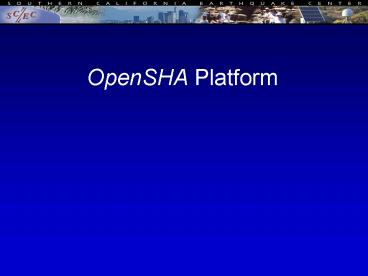OpenSHA Platform PowerPoint PPT Presentation
1 / 23
Title: OpenSHA Platform
1
OpenSHA Platform
2
Status of Seismic Hazard Analysis (SHA)
- SHA needs a more physics based approach
- Lack of consensus means well have multiple
options - All viable models need to be considered for
proper SHA - SHA needs a computational infrastructure capable
of handling a potentially great number of
arbitrarily complex models - (a Community Modeling Environment)
3
SHA products
Seismograms
Hazard Curves
Scenario ShakeMaps
Hazard Maps
4
SHA products
Seismograms
Hazard Curves
1 Site
Scenario ShakeMaps
All Sites
Hazard Maps
5
SHA products
Seismograms
Hazard Curves
TeraShake Platform
Scenario ShakeMaps
Hazard Maps
6
SHA products
Seismograms
Hazard Curves
CyberShake Platform
Scenario ShakeMaps
Hazard Maps
7
SHA products
Seismograms
Hazard Curves
OpenSHA Platform
Scenario ShakeMaps
Hazard Maps
8
OpenSHA
A framework where any arbitrarily complex (e.g.,
physics based) SHA component can plug in for
end-to-end SHA calculations.
- open source
- object oriented
9
The computer code
The applications
10
OpenSHA
A framework where any arbitrarily complex (e.g.,
physics based) SHA component can plug in for
end-to-end SHA calculations.
- open source
- object oriented
- platform ind.
- web/GUI enabled
- distributed (potentially)
- Java (or wrapped code)
- verified
11
OpenSHA
A framework where any arbitrarily complex (e.g.,
physics based) SHA component can plug in for
end-to-end SHA calculations.
Probability of all possible fault-rupture events
(M5) for region time span
e.g. RELM
12
OpenSHA
A framework where any arbitrarily complex (e.g.,
physics based) SHA component can plug in for
end-to-end SHA calculations.
Gives Prob(IMTIML) for a given site and
fault-rupture event
Attenuation Relationships (traditional)
13
OpenSHA
SHA Models Implemented
Intensity-Measure Relationships (Attenuation
Relationships) Boore et al. (1997) Abrahamson
Silva (1997) Campbell (1997) Sadigh et al.
(1997) Field (2000) Abrahamson (2000) Campbell
Bazorgnia (2003) ShakeMap (2003) SEA (Spudich et
al., 1999) USGS Combined (2004) Wells
Coppersmith (1994) NGA models - (coming soon)
Earthquake Rupture Forecasts PEER Area PEER
Non-Planar Fault PEER Multi-Source PEER Logic
Tree Poisson Fault ERF Fault Rupture ERF USGS/CGS
(1996) STEP So. Cal. (2003) STEP Alaska Pipeline
(2003) WGCEP (2002) USGS/CGS (2002) WGCEP UCERF
1.0 Relm Models - (coming soon)
14
OpenSHA Publications
Field, E.H., T.H. Jordan, and C.A. Cornell
(2003). OpenSHA A Developing Community-Modeling
Environment for Seismic Hazard Analysis, Seism.
Res. Lett. 74, 406-419. Field, E.H., H.A
Seligson, N. Gupta, V. Gupta, T.H. Jordan, and
K.W. Campbell (2005). Loss Estimates for a Puente
Hills Blind-Thrust Earthquake in Los Angeles,
California, Earthquake Spectra, 21,
329-338. Field, E.H., N. Gupta, V. Gupta, M.
Blanpied, P. Maechling, and T.H. Jordan (2005).
Hazard Calculations for the WGCEP-2002 Earthquake
Forecast Using Distributed Object Technologies,
Seism. Res. Lett., 76, 161-167. Maechling, P.,
V. Gupta, N. Gupta, E.H. Field, D. Okaya and T.H.
Jordan. (2005) Seismic Hazard Analysis Using
Distributed Computing in the SCEC Community
Modeling Environment, Seism. Res. Lett., 76,
177-181. Field, E.H., V. Gupta, N. Gupta, P.
Maechling, and T.H. Jordan (2005). Hazard Map
Calculations Using OpenSHA and GRID Computing,
Seism. Res. Lett., In Press. Maechling, P., V.
Gupta, N. Gupta, E.H. Field, D. Okaya and T.H.
Jordan. (2005). Grid Computing in the SCEC
Community Modeling Environment , Seism. Res.
Lett., In Press.
15
OpenSHA
Applications Available
1) Hazard Curve Calculator
e.g., WGCEP-2002 ERF (Field et al. 2005,
SRL) Distributed Object Technologies (Maechling
et al., 2005, SRL)
16
OpenSHA
Applications Available
1) Hazard Curve Calculator
2) Scenario ShakeMap Calculator
17
OpenSHA
Applications Available
1) Hazard Curve Calculator
2) Scenario ShakeMap Calculator
Loren Wimmer - SCEC summer intern
Rose Canyon Scenarios
HAZUS Losses
18
OpenSHA
Applications Available
1) Hazard Curve Calculator
2) Scenario ShakeMap Calculator
3) Hazard Map Data Calculator
4) Hazard Map Plotter
19
OpenSHA Collaborative Accomplishments
- Code validation (PEER PSHA Working Group)
- HAZUS study of gt100 WG02, Bay-Area scenarios
(Reasenberg, USGS) - Fault-offset probability computed at the Alaska
Oil Pipeline (for Alyeska) - Hazard calculations for the USGS Short-Term
Earthquake Probability (STEP) maps (USGS,
Pasadena) - Historical MMI tests (Mark Stirling)
- NSHMP application for engineers (E.V.
Leyendecker, USGS Golden) - NSHMP loss estimation methodology (N. Luco, USGS
Golden) - Prototype application for PAGER (P. Earle, USGS
Golden)
20
Ongoing/Near-Future Work
- Implement NGA models (PEER)
- Implementation Evaluation of RELM models
(Stirling) - Implementation of RELM/CSEP tests (Schorlemmer)
- New site effect modules (e.g., Rathje, Stewart)
- Implement Vector-valued PSHA (Thio)
- Educational tutorials (e.g., Stewart)
- Implementation of the WGCEP UCERF
- Full PSHA interface to HAZUS (Seligson
Campbell) - Implement attenuation relationships for new IMT
nonlinear SA (Cornell) - GUI for fault database entry (and other apps
needed by WGCEP)
21
Ongoing/Near-Future Work
- Implement NGA models (PEER)
- Implementation Evaluation of RELM models
(Stirling) - Implementation of RELM/CSEP tests (Schorlemmer)
- New site effect modules (e.g., Rathje, Stewart)
- Implement Vector-valued PSHA (Thio)
- Educational tutorials (e.g., Stewart)
- Implementation of the WGCEP UCERF
- Full PSHA interface to HAZUS (Seligson
Campbell) - Implement attenuation relationships for new IMT
nonlinear SA (Cornell) - GUI for fault database entry (and other apps
needed by WGCEP)
22
Application Development Process
- Design
- Implement
- Test (debug, verify)
- User Manuals
- Release (including legal issues)
23
Atten. Rel. App Demo

